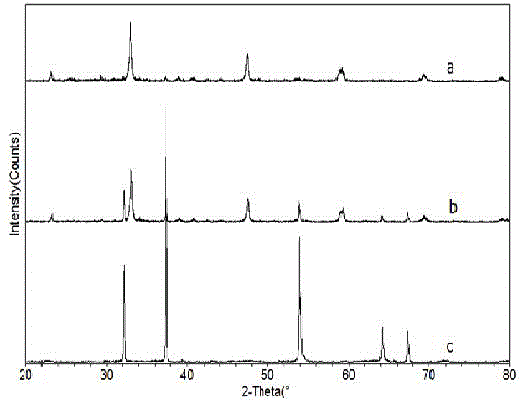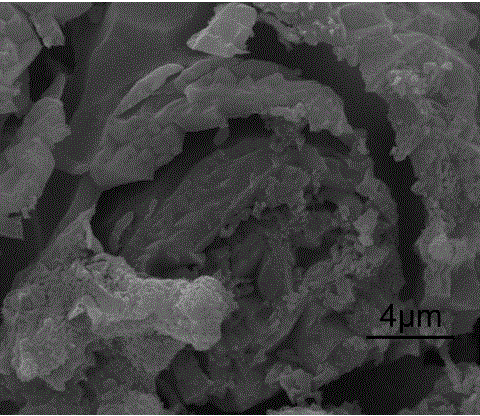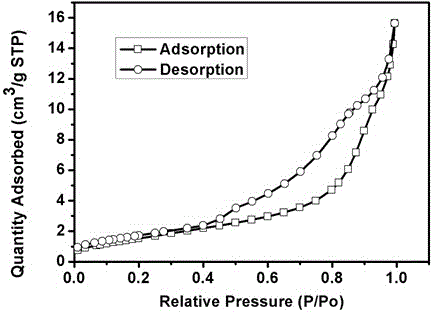A kind of calcium titanate/calcium oxide composite photocatalyst and its preparation method and application
A technology of calcium oxide and calcium titanate, applied in the field of photocatalysis, can solve the problem of low photocatalytic activity, achieve high photocatalytic activity, cheap and easy-to-obtain raw materials, and reduce production costs
- Summary
- Abstract
- Description
- Claims
- Application Information
AI Technical Summary
Problems solved by technology
Method used
Image
Examples
Embodiment 1
[0041] (1) Dissolve 0.0491mol of butyl titanate in 80ml of absolute ethanol, ultrasonicate for 1h, and let stand for 12h;
[0042] (2) Add 0.0491mol of solid calcium nitrate tetrahydrate into 80ml of 95% ethanol solution, heat and stir at 60°C to fully dissolve, then add 15ml of glacial acetic acid, and stir well for 0.5h;
[0043] (3) Under full stirring, the solution obtained in step (2) is added dropwise to the solution obtained in step (1), and stirring is continued for 1 h, wherein the molar ratio of calcium to titanium is 1:1;
[0044] (4) aging the solution obtained in step (3) at room temperature for 24h;
[0045] (5) Put the obtained pale yellow transparent gel into an oven to dry at 60°C to obtain a pale yellow solid;
[0046] (6) Put the dried light yellow solid into a muffle furnace for calcination at 500°C for 2h, and the heating rate is 1°C / min, and the obtained white powder is the calcium titanate / calcium oxide composite photocatalyst.
[0047] 10 mg of ca...
Embodiment 2
[0049] (1) Dissolve 0.0491mol of tetraisopropyl titanate in 80ml of absolute ethanol, sonicate for 1h and then let stand for 12h;
[0050] (2) Add 0.0491mol of solid calcium nitrate tetrahydrate into 80ml of 95% ethanol solution, heat and stir at 60°C to fully dissolve, then add 15ml of glacial acetic acid, and stir well for 0.5h;
[0051] (3) Under full stirring, the solution obtained in step (2) is added dropwise to the solution obtained in step (1), and stirring is continued for 1 h, wherein the molar ratio of calcium to titanium is 1:1;
[0052] (4) aging the solution obtained in step (3) at room temperature for 24h;
[0053] (5) Put the obtained pale yellow transparent gel into an oven to dry at 60°C to obtain a pale yellow solid;
[0054] (6) Put the dried light yellow solid into a muffle furnace for calcination at 700°C for 2h, and the heating rate is 1°C / min, and the obtained white powder is the calcium titanate / calcium oxide composite photocatalyst.
[0055] 2 mg of...
Embodiment 3
[0057] (1) Dissolve 0.0491mol of butyl titanate in 80ml of absolute ethanol, ultrasonicate for 1h, and let stand for 12h;
[0058] (2) Add 0.0491mol of calcium chloride dihydrate solid into 80ml of 95% ethanol solution, heat and stir at 60°C to fully dissolve, then add 15ml of glacial acetic acid, and stir well for 0.5h;
[0059] (3) Under full stirring, the solution obtained in step (2) is added dropwise to the solution obtained in step (1), and stirring is continued for 1 h, wherein the molar ratio of calcium to titanium is 1:1;
[0060] (4) aging the solution obtained in step (3) at room temperature for 24h;
[0061] (5) Put the obtained pale yellow transparent gel into an oven to dry at 60°C to obtain a pale yellow solid;
[0062] (6) Put the dried light yellow solid into a muffle furnace for calcination at 600°C for 4h, and the heating rate is 1°C / min, and the obtained white powder is the calcium titanate / calcium oxide composite photocatalyst.
[0063] 2 mg ...
PUM
 Login to View More
Login to View More Abstract
Description
Claims
Application Information
 Login to View More
Login to View More - R&D
- Intellectual Property
- Life Sciences
- Materials
- Tech Scout
- Unparalleled Data Quality
- Higher Quality Content
- 60% Fewer Hallucinations
Browse by: Latest US Patents, China's latest patents, Technical Efficacy Thesaurus, Application Domain, Technology Topic, Popular Technical Reports.
© 2025 PatSnap. All rights reserved.Legal|Privacy policy|Modern Slavery Act Transparency Statement|Sitemap|About US| Contact US: help@patsnap.com



